No matter how strong the stem is, all gardeners recommend tying tomatoes in the open field. Any varieties of tomatoes require timely garters, and especially tall ones – those that reach 2 meters in height. Low-growing varieties are often not tied up at all, but the proportion of their cultivation compared to taller varieties that give a more abundant harvest is constantly decreasing, because everyone is striving for the expedient use of every square meter of land on the site. Therefore, with the same care, labor costs and planting area, high varieties are more rational and cost-effective than their low counterparts.
What gives a garter
A tomato garter is not a tribute to garden traditions, but a “production necessity”. This simple procedure has a lot of benefits for your future harvest, namely:
- The stem will not bend and break as it grows and under the weight of the fruit, so its vitality will not be used to fight for survival, but will only be aimed at a good harvest.
- With a vertical arrangement of the tomato bush, it will be as open as possible to sunlight and fresh air, so it will develop sufficiently, because the plant loves the sun and will give an excellent harvest.
- Inevitable rains and downpours will not be able to damage the tomato in the open field if it is securely fixed on an additional support.
- Tied tomatoes are easier to spray, and the effectiveness of the procedure will be higher, so such bushes will be less susceptible to diseases characteristic of growing these vegetables.
- It is also much easier to carry out other procedures for the care of seedlings in the open field: mulching, hilling, weeding, pinching
- Garter of a tomato stem will simplify watering, because, based on the correct growing technology, the vegetable does not welcome the ingress of excess moisture on the leaves, so it is better to do any water procedures near the root.
- Tying up the stem will keep the fruit some distance off the ground, so your crop won’t become a dining room for slugs or mice.
- Excessive soil moisture will not harm the ripening of the fruit if they are not located on the ground, so the garter will keep the vegetables from rotting on the branches.
Namely, based on the above positive aspects of the tomato garter, experienced gardeners never forget about this stage of growing a vegetable.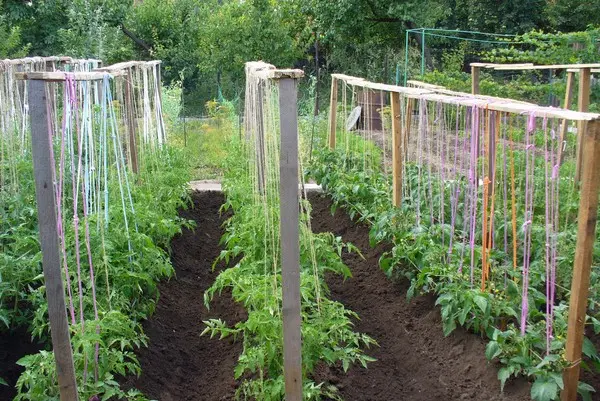
The construction of garter devices should begin 2 or 3 weeks after planting seedlings in open ground. In total, you will need to strengthen the stem 3-6 times during the season by tying it to a support. The amount will depend on the tallness of the variety you choose to grow.
Methods
With the development of horticulture, the breeding of new crops by breeders and the invention of modern materials, several methods of gartering a tomato when grown in open ground have appeared and taken root in vegetable growing. Each of them has proven its effectiveness in practice, so you can safely choose any that is convenient for you and your summer cottage. You may even be able to invent something of your own based on them, so let’s take a closer look at each option on how to properly tie up tomatoes.
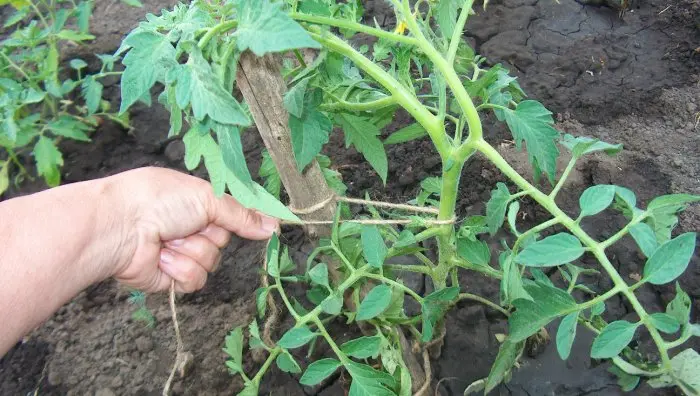
To begin, note that any of the methods below use materials that do not harm the plant, so follow the tips and you will never have problems growing tomatoes. The twine, which you will use as a handy tool in order to tie up the tomato bushes, must not be tightened tightly so that it does not crash into the stem of the plant. For fastenings, any fabric torn into strips, twine or other type of rope will do. Wire or fishing line will not work at all, because it can cut deep into the stem and irreparably destroy it.
Natural fabrics are good, but not entirely acceptable for open ground, because. can rot and fall off, but even worse, become an incubator for a pathogenic infection. Therefore, we will choose something synthetic, but not too thin to tie up the stem. By the way, you can use materials for gartering grapes. In any case, the rule applies: the garter material is chosen by you for one year, and then thrown away so as not to transfer a possible infection or disease to new seedlings of the next year.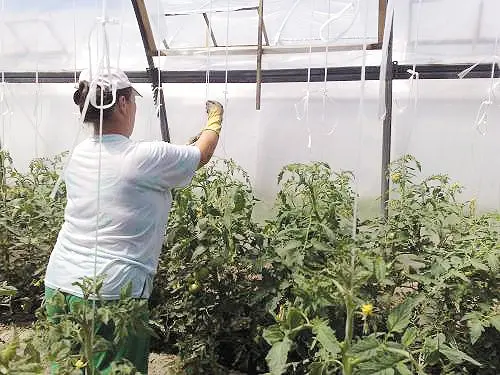
Stakes
The first, and also the most common way for open ground, is the use of tall pegs. Stakes can be metal or wooden, their material does not matter, the main thing is to use them on time and correctly. The height of each peg should correspond to the “growth” of the tomato bush.
For low and medium-sized varieties, you can choose materials 20-30 cm above the seedlings, but tall ones will require longer stakes – up to 2-2,5 m.
Each of the pegs should be strengthened in the ground so that it holds firmly, usually deepened by 20-25 cm, retreating from the stem of the tomato by about 10 cm, so that the root system is not inadvertently damaged by you. You need to tie the tomato loosely, it will be right to first fix the string on a peg, then wrap the stem around and tie. As the vegetable grows, we perform this process several times.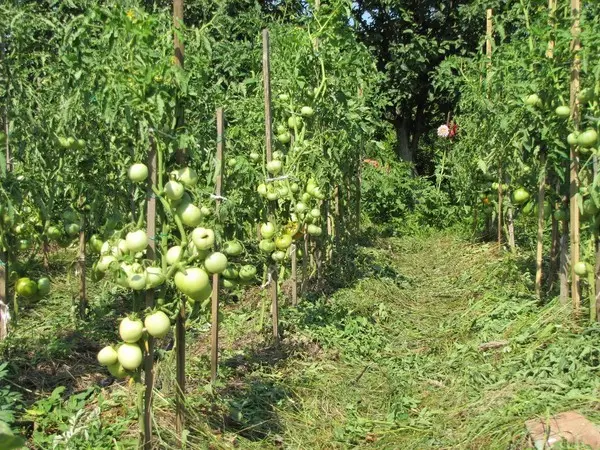
On the trellis
If you have a tomato plantation, it would be more rational to use a different garter method. It will require a thin beam or strong pegs, and their number is much less than in the method described above. We drive in the racks at the beginning and end of the tomato beds, we stretch the wire between them. With this method, you will need to tie the stem of the tomato to a stretched wire. You can tie up a plant like this if you planted a tall variety of tomato, and using a stretched wire is available in several options:
- pull a strong wire onto a high beam at a level of about 2 m – then the strings for the garter should be long enough to reach both the support (wire) and the stem. Tomato lashes will wrap around these ropes as they grow;
- pull several rows of wire, fixing them on the beam. Then each bush will need to be tied up separately several times to the formed stretch or pass the stem as it grows through the horizontal stripes so that the braid comes out of the tomato.
In any case, do not forget to tie up correctly – do not tighten the rope tightly on the stem. By the way, in this way, you can also tie up separate brushes with fruits, which often turn out to be very weighty.
If the bed is long, then it will be necessary to strengthen the structure by driving in additional intermediate stakes, then no wind will be terrible for your garter. And if you plant 2 beds parallel to each other at a short distance, then the design will come in handy for tying tomatoes from both at once: you will get a kind of tomato hut.
Cells
With a little effort, you can design entire structures for the garter that will last you for a year. These will be original cells for vegetables. They are built separately for each bush. First, several circles of the same diameter are made of dense reinforcing wire, then they are fixed at the insistence of each other on vertical racks of the same wire. It turns out a cylindrical wire cage, which is installed at the same time as the pegs, and then, as the bush grows, you only need to tie up the stem in time.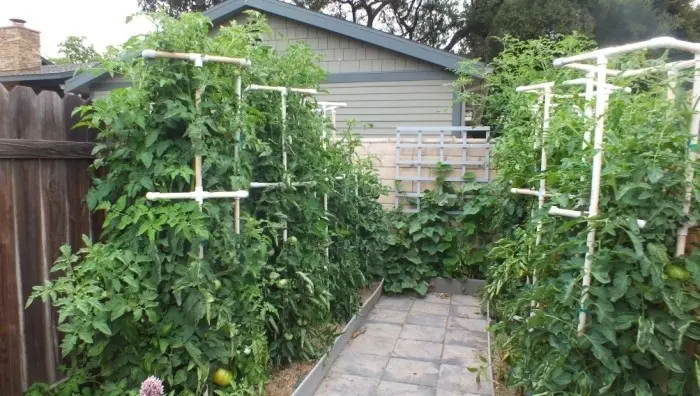
If you cannot find a wire, then you can build a similar frame of wood, fastening the stakes together like a stool, only without a seat. If you make such a cage wide enough, then it is able to cover 4 bushes of tomatoes – for each “leg” of the structure. This is much more reliable than driving in individual pegs.
Caps
Unusual designs and convenient designs of a different kind – caps. They are suitable for tying not only a tomato. The bottom line is that you need to build a tall narrow “wigwam” or a pyramid from improvised means. 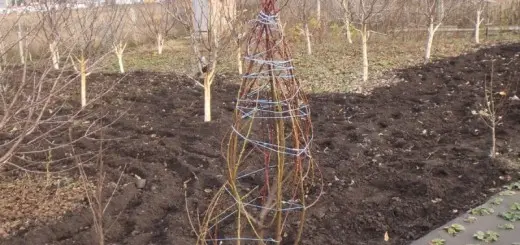 It can be wire, vine or stakes in a cross-knit warp in the form of a cage. Install similar caps along with planting seedlings, and they are useful for tying several bushes at once. Such pyramids should be placed at some distance from each other so that there is no crowding of plants, usually it is 1 meter or a little more if the site allows.
It can be wire, vine or stakes in a cross-knit warp in the form of a cage. Install similar caps along with planting seedlings, and they are useful for tying several bushes at once. Such pyramids should be placed at some distance from each other so that there is no crowding of plants, usually it is 1 meter or a little more if the site allows.
Video “Garter of tomatoes”
A record of how easy it is to tie up tomatoes with a dense thread without harming the plant.









